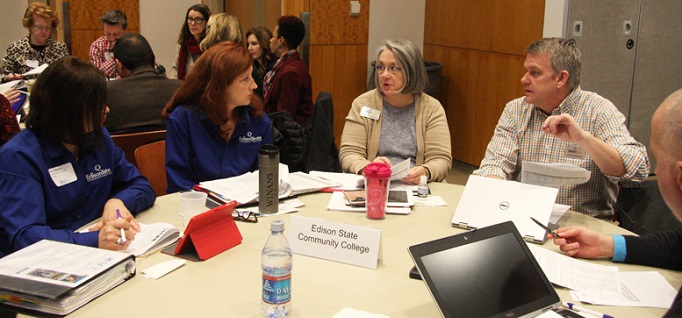Ohio colleges share success strategies
By Ellie Ashford
April 12, 2017
A leadership institute launched by the Ohio Association of Community Colleges helps colleges determine which reforms to work on and how to put them in place.
When Ohio passed a law requiring every community college to develop and implement a completion plan – showing how they plan to improve student outcomes – the Ohio Association of Community Colleges (OACC) offered a helping hand.
The association’s Student Success Center launched a leadership institute in 2015 that periodically brings together teams from each of the state’s 23 community colleges to help them determine which reforms to work on – such as developmental education or guided pathways – and how to put them in place.
OACC President Jack Hershey and leaders of several colleges will give a presentation on Ohio’s statewide Student Success Leadership Institute (SSLI) at the American Association of Community Colleges’ (AACC) annual conference in New Orleans April 22-25.
At the SSLI, college teams have an opportunity to learn success strategies from college leaders on the front line who have been engaged in AACC’s Pathways Project, Completion by Design and Achieving the Dream and from national experts at the Community College Research Center and the National Center for Inquiry and Improvement.
When Ohio adopted a college system that is 100 percent based on outcomes, “there was a desire that all colleges share an opportunity to have access to the best research,” Hershey says.
Each college brings a team to the SSLI, including such participants as the president, vice president of academic affairs, dean of arts and sciences, dean of student services, academic advisers, institutional researcher, registrar, director of student success and faculty members.
“We’ve been very intentional about having colleges share their work with others,” says Laura Rittner, head of OACC’s Student Success Center.
Various parts
The association also implemented a coaching strategy that pairs colleges that have implemented successful reforms – in developmental education, advising and other areas – with colleges not as far along.
“Guided pathways is the cornerstone of this initiative,” Hershey says, and reforming remediation is also a big part of it.
The college completion plans were due last June, Rittner says. Now the OACC initiative is helping colleges implement the plans, through coaching and workshops. Next year, the colleges will update their plans based on evidence about what’s working.
A key step in the process is the formation of data teams at colleges, Hershey says, because “so much of this reform requires colleges to understand data and be able to communicate the data across the campus.”
“Rising stars from institutional research departments or ATD” have been assigned to work with one to three colleges to help them build capacity working with data, he says.
CCRC is doing research to support this effort, Rittner adds, and OACC is working with the Ohio Department of Higher Education to pull key performance data so “we can more quickly assess whether we’re moving in the right direction.”
Guided Pathways
As a result of its work with the SSLI, Clark State Community College is implementing several initiatives, including guided pathways, says President Jo Blondin. The goal is to ensure that students are on the right path from the start, and to guide them onto alternative pathways when they are not accepted into a program with selective admissions, such as registered nursing.
The college has also grouped all of its academic programs into 10 career clusters to ensure that students take the right courses to complete a degree or certificate, and it has designed stackable certificates for students so they can attain that first credential.
Additionally, Blondin says, Clark State has redesigned its developmental education courses for occupational programs using the I-BEST (Integrated Basic Education and Skills Training) model.
The college has already shown some improvements in student outcomes, including increases in course completion and a decrease in overall credit hours that students take to graduate.
There’s more to the story! Read the full article in CC Daily.


